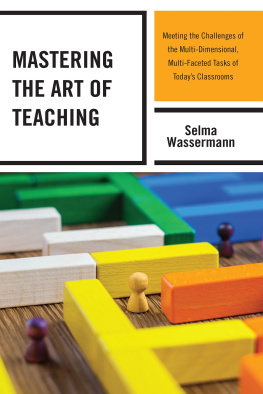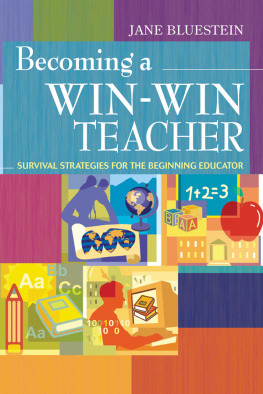Mastering the Art
of Teaching
For Paula, my darling girl
Mastering the Art
of Teaching
Meeting the Challenges of the
Multidimensional, Multifaceted
Tasks of Todays Classrooms
Selma Wassermann
ROWMAN & LITTLEFIELD
Lanham Boulder New York London
Published by Rowman & Littlefield
An imprint of The Rowman & Littlefield Publishing Group, Inc.
4501 Forbes Boulevard, Suite 200, Lanham, Maryland 20706
www.rowman.com
6 Tinworth Street, London SE11 5AL, United Kingdom
Copyright 2021 by Selma Wassermann
All rights reserved . No part of this book may be reproduced in any form or by any electronic or mechanical means, including information storage and retrieval systems, without written permission from the publisher, except by a reviewer who may quote passages in a review.
British Library Cataloguing in Publication Information Available
Library of Congress Cataloging-in-Publication Data
Names: Wassermann, Selma, author.
Title: Mastering the art of teaching : meeting the challenges of the multi-dimensional, multi-faceted tasks of todays classrooms / Selma Wassermann.
Description: Lanham, Maryland : Rowman & Littlefield, 2021. | Includes bibliographical references and index. | Summary: The book not only identifies and explains what teachers do but also makes suggestions for new and practicing teachers may further hone those skills that each task demandsProvided by publisher.
Identifiers: LCCN 2020042777 (print) | LCCN 2020042778 (ebook) | ISBN 9781475858648 (cloth) | ISBN 9781475858655 (paperback) | ISBN 9781475858662 (epub)
Subjects: LCSH: Teaching. | First year teachers. | TeachersIn-service training. | Teacher-student relationships.
Classification: LCC LB1025.3 .W376 2021 (print) | LCC LB1025.3 (ebook) | DDC 371.102dc23
LC record available at https://lccn.loc.gov/2020042777
LC ebook record available at https://lccn.loc.gov/2020042778
 The paper used in this publication meets the minimum requirements of American National Standard for Information SciencesPermanence of Paper for Printed Library Materials, ANSI/NISO Z39.48-1992.
The paper used in this publication meets the minimum requirements of American National Standard for Information SciencesPermanence of Paper for Printed Library Materials, ANSI/NISO Z39.48-1992.
Contents
This book could not have been written without the help of many people, and I want to acknowledge them with grateful appreciation for their support and their valuable input. First and foremost, to my beloved grandson, the wizard of Parksville, Simon, who is always available to bail me out of whatever computer problem that baffles me. My adorable great granddaughter, Maya, made a substantial contribution about her work in her Grade 4 IT class; her responses to my questions made clear the extent and nature of how IT is being used to enrich her curriculum.
Richard Dancy, the reference archivist at Simon Fraser University, is able to put his hands on previously published Wassermania now lodged in the archives, replying ever rapidly to my requests. Kelli Vogstead provided me with that five-year-old philosopher Elis advice to new teachers, and I thank her for that terrific piece of work. Former colleague and friend Wally Eggert, coauthor of the Profiles of Teaching Competency , consented to allow me to include the Profiles in the Appendix of this text. In his book Whats Your Pronoun , Dennis Baron gave me implicit permission to use they in lieu of the more awkward he and she as a pronoun for a singular nounalthough it is still hard for me to do that.
Anne Bauer, editor for Childhood Education , has been generous in allowing me to adapt material from previously published articles in the journal, specifically Changing Course: Rethinking Teacher Education Course Design from CE , Vol. 93, 2017 and Empowering Students Through Teacher Student Interactions: Teacher Talk That Makes a Difference, from Focus on Later Childhood/Early Adolescence , Winter, 1999, Vol. 2.
Thanks, too, to Sage Publishing, for permission to adapt material from Leaving, published in the Kappan , June 2002, and to Teachers College Press, for their permission to adapt material from previously published books, as cited in the relevant sections of the book.
And finally, to my reviewers, who took time from their busy schedules to read and give me feedback that enriched my thinking and my prose: Gary Squire, Tom OShea, Wally Eggert Bill Cliett, and Maureen McAllisterheartfelt thanks for your help and support.
Like many of you readers, I have had a few master teachers in my life, and I am blessed to have had my life enriched by them. The teaching strategies they used and the classroom experiences we had were heads and shoulders above and beyond what I had experienced before, and that was obvious from the very first day. There was an ethos in those classrooms that spoke to me as wella sense that we students were a community of learners and that what was on offer was special. There are many good reasons that these teachers are remembered and held in such high regard.
When I was introduced to the importance of teacher-student interactions and their effect on student learning, I would, in a free period, sit in on Louis Rathss classesnot to hear, again, what he had to say about students needs, values, and thinking but to watch him as he listened, questioned, interacted respectfully with each student, always with an ear to the importance of what each was saying. He made each of us feel as if we were partners in learning, together exploring ideas that would illuminate our thinking and our understanding. Watching him was like being in a master class. I was studying the master and trying to bring some of those teaching strategies into accord with my own.
Coming to an appreciation of how case method teaching could be a useful curriculum tool for promoting student thinking and awareness of critical issues in subject areas, I sat in Chris Christensens classes at the Harvard Business School, observing and studying the way he taught a case. Once again, his respect for every student in that class was manifest; his questions, probing, insightful, clarifying. He seemed to know when to question, when to reflect, when to probe, when to confront. The students seemed rapt in attention, listening, carefully forming their own responses to his queries. His orchestration of a class discussion I compared to Toscanini conducting the New York Philharmonic, and I left his classes on a high, better aware of the superior skills of teacher-student interactions. This was teaching at the highest level of art.
Dr. Ed Lipinksi was the chief medical officer and psychiatrist in the Health Services division of the university where I taught for many years. He took me in hand and gave me two years of tutorials in counselling, where I sharpened my skills as a respectful listener, and more important, learned to make thoughtful and insightful diagnosis into human behavior, which led to more effective interventions in dealing with presenting problems. He was patient and kind, and he knew when to ask and when to advise. His knowledge of human behavior and counselling interventions gave me deeper insights into the rationale for why some humans behave as they do.
Not every teacher is, in fact, a teacher by profession. There are a few masters outside of the profession who do teach and whose lessons have great impact. On one sabbatical, I wormed my way into the lives of a group of bakers, to learn more about the process of producing high-quality French pastry. I spent two weeks sweating in front of the ovens of Fantasia Bakery in South San Francisco, where I began my apprenticeship by being allowed to shape the dough of croissants that were just ready to go into the ovens. About eight hundred of them each morning.













 The paper used in this publication meets the minimum requirements of American National Standard for Information SciencesPermanence of Paper for Printed Library Materials, ANSI/NISO Z39.48-1992.
The paper used in this publication meets the minimum requirements of American National Standard for Information SciencesPermanence of Paper for Printed Library Materials, ANSI/NISO Z39.48-1992.